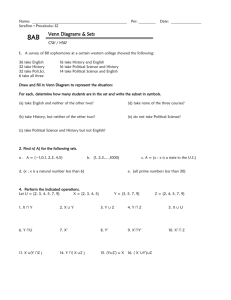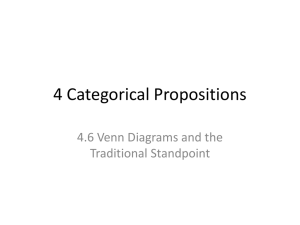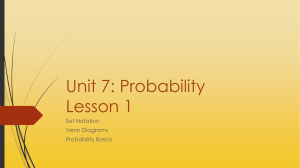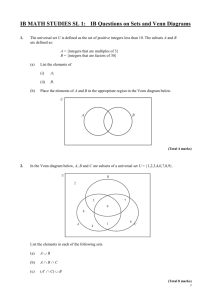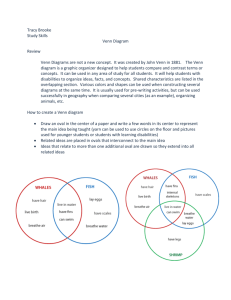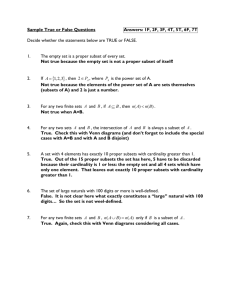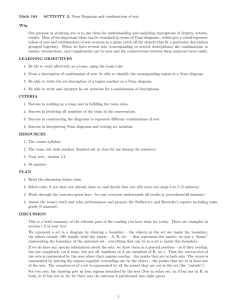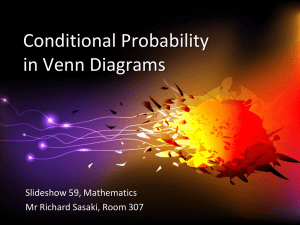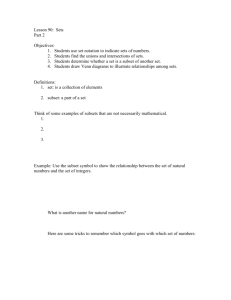06-01-set-theory
advertisement
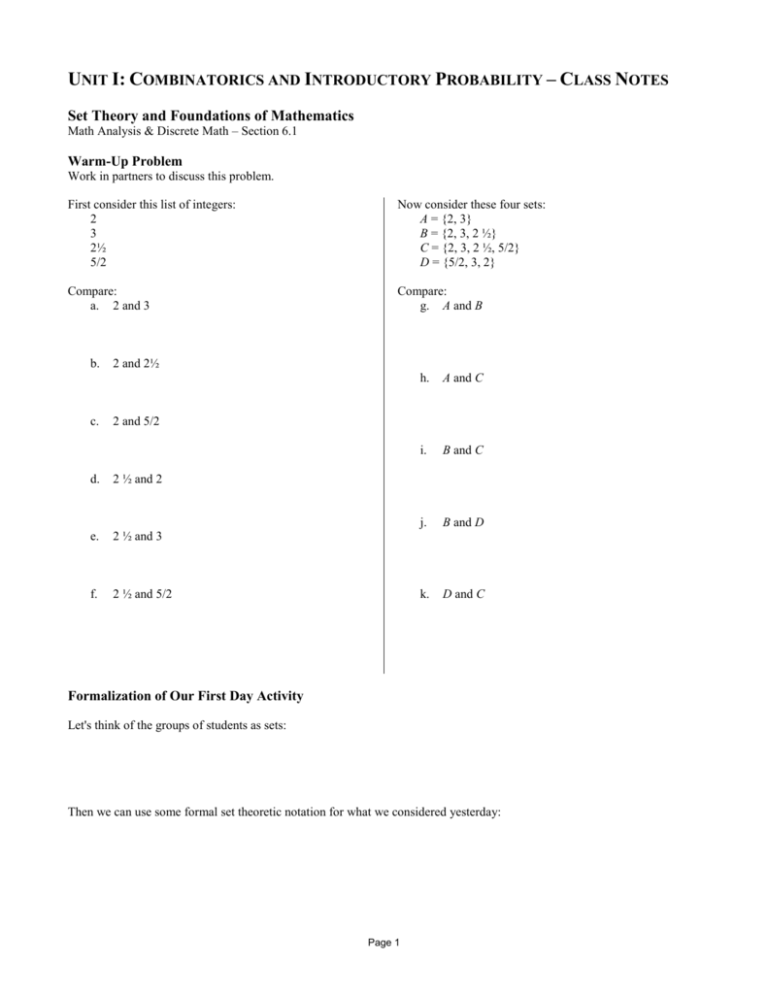
UNIT I: COMBINATORICS AND INTRODUCTORY PROBABILITY – CLASS NOTES
Set Theory and Foundations of Mathematics
Math Analysis & Discrete Math – Section 6.1
Warm-Up Problem
Work in partners to discuss this problem.
First consider this list of integers:
2
3
2½
5/2
Now consider these four sets:
A = {2, 3}
B = {2, 3, 2 ½}
C = {2, 3, 2 ½, 5/2}
D = {5/2, 3, 2}
Compare:
a. 2 and 3
Compare:
g. A and B
b.
c.
2 and 2½
h.
A and C
i.
B and C
j.
B and D
k.
D and C
2 and 5/2
d.
2 ½ and 2
e.
2 ½ and 3
f.
2 ½ and 5/2
Formalization of Our First Day Activity
Let's think of the groups of students as sets:
Then we can use some formal set theoretic notation for what we considered yesterday:
Page 1
The Properties of Sets
Question from Geometry: What is the definition of a point?
Question: How do we formally define what a set is? How about an element of a set?
Historical Note: Georg Cantor, a German mathematician, is the brainchild of set theory. His work was done in the 1800s.
Some textbooks will use M to denote a generic set. This comes from the German word Menge.
The following axiom is really the heart of set theory:
The Axiom of Extension:
a set is completely defined by its elements
order of elements is irrelevant
an element may be listed twice - also irrelevant
Examples of Writing Sets
We use the symbol "" to mean "is an element of." We use the vertical bar "|" to mean "such that" in writing sets. It is
convention that we usually use capital letters to denote sets. We use lowercase letters to denote single variables. (Actually,
capitals are also used for other data structures like matrices and graphs and trees, so what really dictates whether a variable is
capitalized or not is "how big" it is.)
Here are several examples of how we may write sets:
A = {2, 5, 8}
S = {-2, 5, e, }
D = { 0, 1, 2, 3, 4, 5, 6, 7, 8, 9}
Z3 = {0, 1, 2}
Q = {square, rectangle, parallelogram, rhombus, trapezoid}
M[x] = {x, x2, x3, … , 2x, 2x2, … } = {monomials in x with integer coefficients}
E = {x | x is an even digit} = {0, 2, 4, 6, 8}
O = {x | x is an odd digit} = {1, 3, 5, 7, 9}
Z = {…, -3, -2, -1, 0, 1, 2, 3, …} = {z | z is an integer }
a b
M2,2 =
a,b,c,d Z
c d
Page 2
"Mathese": Some Foundations of Logic
First scenario:
Given these statements:
p: 2 < 3
q: 2 = 4/2
r: 2 is not an integer
Discuss these statements with a partner and determine whether they are true or false:
p and q
p or q
p and r
p or r
q and r
q or r
Question:
In what different ways can "or" be interpreted? What names do we give to these different forms of "or" in mathematics (and
computer science, especially)?
Second scenario:
Given these statements:
p: Q is a rectangle
r: Q has 4 90-degree angles
Discuss these statements:
If p then r
If r then p We call this the converse of the previous statement.
Now add this statement:
s: Q is a square
Then discuss these statements:
If s then r
If r then s
Notes of importance:
1.
A statement and its converse are not logically equivalent. Can you come up with a good counterexample?
Page 3
2.
When both " if p then q" and "if q then p" are true, we say "p if and only if q" is true. We abbreviate "if and only if"
as "iff." (So that is NOT a typo!)
The Language of Set Theory
Term
Symbol
Definition
Example
element
(x is an
element of A)
equal sets
(A and B)
empty set
subset
(A is subset of B)
proper subset
(A is proper
subset of B)
universal set
union
(of sets A and B)
intersection
(of sets A and B)
disjoint sets
(A, B are disjoint)
complement
(of set A)
Also worth noting here is that we put vertical bars around a set to refer to the size of a set. For example, let set A = {1, 2}.
Then, since A has 2 elements, we write |A| = 2.
Page 4
Practice Problems
Consider the following sets:
U 1,2,3,4,5,6,7,8,9,0
L 5,6,7,8
A 3,8
C 2,4
G 5,6
Determine the following:
1.
A L
2.
A L
3.
A
4.
L
5.
AL
6.
AL
7.
A L
8.
A L
9.
A C
When you're finished:
Can you make any
other observations
using vocabulary?
Any conjectures?
10. G L
Page 5
First Homework Assignment: Section 6.1, #1-12. (You may find it helpful to bring colored pencils or pens for the next few
days too.)
Warm-Up
Consider the following sets:
A = {1, 2, 3}
B = {1, 2, 3, 4, 5}
C = {3, 2, 1}
Determine whether each of these statements is true or false. Justify.
a.
A=C
f.
A C
b.
AB
g.
AA
c.
BA
h.
A
d.
A B
i.
B
e.
CA
Prove or disprove and salvage if possible: For any set S, S S.
Venn Diagrams
Sometimes it's nice to give a visualization of sets. British Mathematician John Venn set the standard for this in 1881; hence
what we are about to do is called a Venn Diagram.
We'll first work in the context of the set above. In the figure below, identify each sets A, B, and C. Let set D = {5, 7}. Identify
it as well. Then verify the statements above by inspection using the figure.
1
5
2
7
4
3
8
Now find A B, A D, and B D using the figure. Make smaller sketches below and shade in the relevant sets.
Page 6
In the previous example, we considered Venn Diagrams for a situation where we could actually see all of the elements.
Usually, that is not the case. Venn Diagrams are really for abstract reasoning…
Examples:
AB
AB
A
A
B
B
U
U
A B
A
A
A
B
B
U
U
Question: How would you draw the Venn Diagram for sets A and B when A and B are disjoint sets?
Problems:
Shade Venn Diagrams for each of the following sets. What do you observe?
A B
A B
A
A
B
B
U
U
A B
A B
A
A
B
U
B
U
Page 7
The previous problem illustrates a set of important laws of logic:
DeMorgan's Laws
For any two sets A and B,
A B A B
A B A B
More Venn Diagrams Exercises
Now we consider three sets. Again, shade the Venn Diagrams.
ABC
ABC
B
A
C
C
U
A (B C)
U
(A C) B
B
A
C
B
A
C
U
U
A CB
A (B C)
B
A
B
A
C
B
A
C
U
Second Homework Assignment: 6.1: #20, 23-30, 34-38
Page 8
U
Set Theory Problems to Consider – Food for Thought!
Work with your group or 3 or 4 students. Write out all thoughts, work, etc. Come up with examples, counterexamples, Venn
Diagrams, etc. For proof, ultimately give analytical arguments. Discuss your thoughts with your group members.
1.
Prove or disprove and salvage if possible (PODASIP): A for all A.
2.
True/False: A U.
3.
PODASIP: A B A B
4.
Can you come up with a similar identity for A B _______?
5.
What is A ?
6.
A = _______?
A = _______?
7.
A A = ______?
A A = ______?
Page 9
